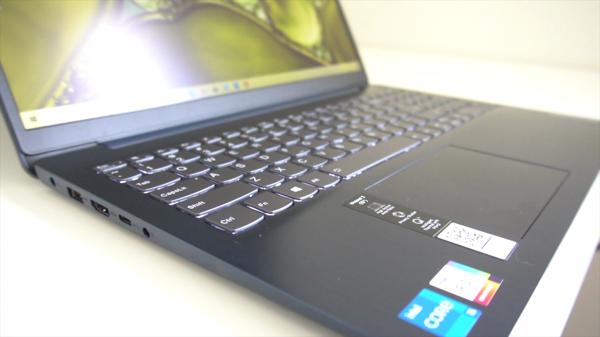My budget laptop experience: Lenovo IdeaPad 3 (2023)
Introduction
I recently picked up the Lenovo IdeaPad 3, a budget-friendly laptop. I quite appreciate durability and performance without paying a hefty price for it - this laptop seemed to offer all of this. Below are some of my impressions.
Initial Impressions and Build Quality

When it comes to laptops, we often have to balance cost against quality and performance. My latest acquisition, the Lenovo IdeaPad 3, lands squarely in the realm of budget computing, but don't let its affordability fool you — this device packs a punch where it counts.
I must commend Lenovo on the build quality of the IdeaPad 3; it feels solid and durable, much like the IBM ThinkPad models from yesteryear, which many will recall for their robust construction. Lenovo's legacy of sturdy laptops seems to be holding, albeit in a modern avatar. The chassis doesn't creak or give the impression it might buckle under stress. The hinge is rigid, requiring two hands to open, but I prefer this over a flimsy mechanism any day.
The keyboard is another high point. Typing is a breeze, with satisfying feedback and no discernable flex. This may be one of the best keyboards I've encountered in a budget laptop, rivaling that of higher-end models. It's perfect for long coding sessions or writing reports.
However, the IdeaPad 3 isn't without its drawbacks. While I don't expect top-tier components at this price point, the lack of certain features stands out. Notably, the absence of a USB-C port feels like a significant omission in a time when the industry is moving towards a universal charging and connectivity standard. Information on the value of USB-C can be found in numerous research papers and tech articles, such as those found on IEEE Xplore.
The audio-visual capabilities also lean towards the basic side. The sound output is sufficient for personal use but won't fill a room, and while I will delve deeper into the screen's quality in another section, let's say it's serviceable for daily tasks. It's no surprise some users might feel the audio and visuals are a step down from their previous devices.
Another point of contention is the decision to place USB ports on the left side rather than the right. It's a minor inconvenience, but it's these small details that can affect the user experience, especially for those who have specific setups with peripherals.
On the topic of storage, the onboard SSD may feel cramped for some, but there's a silver lining here. An external hard drive can mitigate the issue without the need to pry open the laptop for an upgrade. The process of installing an external drive is straightforward and a skill-set that every budget-conscious consumer should learn. Instructions and guidance can often be found on technology forums such as those on Reddit.
Despite these gripes, I believe the Lenovo IdeaPad 3 stands as a testament to what you can get on a budget without sacrificing the essentials. It's lightweight enough to be portable, it has enough oomph for productivity tasks, and the battery life is adequate for a day's work or study. The IdeaPad 3 is, without doubt, a smart pick for students, remote workers, and casual users who require a reliable laptop without breaking the bank.
Performance and Everyday Use

In the realm of budget computing, the Lenovo IdeaPad 3 has emerged as a solid contender. Through daily use, it's become clear to me that for the price point, you're getting a dependable machine that ticks many essential boxes for both students and casual users.
The performance is quite satisfactory for everyday tasks. The AMD or Intel processors offered in various configurations provide enough punch to handle web browsing, office applications, and even some light photo editing without breaking a sweat. I've been tinkering with coding projects and I've found that the IdeaPad 3 manages quite well, especially when you consider the price you pay for it. I wouldn’t go as far as to say it's a developer’s dream, but it doesn’t lag behind in the essentials.
From a usability standpoint, I can vouch for the keyboard - one of the best I've laid my hands on in the budget category. Typing is a breeze, and there's a reassuring solidity to each keypress. Despite not being backlit, it’s a minor trade-off for the quality you’re getting.
Sadly, there are some drawbacks. The lack of USB-C feels like a step back especially when most peripherals are moving towards that standard. I find it a bit old-fashioned, although the presence of an SD Card reader is a bonus for those who need it.
The 8GB of RAM initially raised my eyebrows, but in practice, it has proven to be sufficient for daily multitasking. It's a noteworthy feature that for such a cost-conscious device, it doesn’t feel skimpy on memory.
One unavoidable consideration with budget laptops is upgradeability. While the IdeaPad 3 has options to increase storage, the RAM can be a bottleneck. I’ve seen discussions on platforms like Reddit where users lament the ceiling on RAM upgrades due to soldered components.
Portability is also commendable. The IdeaPad 3 is light enough to not be a burden during commutes or moving between classes. It nestles into my backpack with ease and the battery life is respectable, often stretching through most of my day on a single charge.
Let’s talk about gaming - it's not a dedicated gaming laptop by any stretch, but I've found it sufficient for older titles and less demanding indie games. That's a pleasant surprise in a segment where gaming is generally an afterthought.
In the competitive market of budget laptops, Lenovo’s IdeaPad 3 stands out as a sensible choice. For basic home, office, or educational use, it overshadows its shortcomings with reliable performance and a quality keyboard that enhances the user experience. It isn't perfect - but as someone who has worked with numerous budget laptops, I keep leaning back to the IdeaPad 3 when friends and family ask for an affordable recommendation. If your computing needs align with what this laptop offers, it's worth a serious look.
Screen Quality and Viewing Experience

When it comes to the screen quality of the Lenovo IdeaPad 3, I have mixed feelings. In terms of resolution, the FHD (1920x1080) is reasonable for a budget laptop. However, the actual viewing experience doesn't quite hit the mark, especially when compared to higher-end devices or even some similarly priced competitors.
After unboxing, the first thing I noticed is that the brightness and sharpness just aren't there. For general tasks like browsing and document editing, it's passable. But for activities where color accuracy and image clarity are essential, like photo editing or watching high-definition videos, the screen falls short. The colors seem somewhat washed out, and details can appear murky.
This doesn't mean it's all bad news, though. The matte finish on the screen does help reduce glare, which is a plus point for me as I often work in brightly lit environments. Also, for basic tasks like coding and word processing - which doesn't require rich colors or deep contrasts - the display meets the requirements.
I've read up on various forums, including discussions on Reddit, where other IdeaPad 3 users noted similar screen experiences. Some users have suggested tweaking display settings or using third-party software to enhance the visuals, which can provide marginal improvements but doesn't entirely overcome the hardware limitations of the panel.
One must also consider the trade-off for the price. It's impressively affordable, and for someone who needs a reliable device for typing, emails, or managing spreadsheets, the trade-off in screen quality might be acceptable.
The viewing angles are another concern. The use of a VA panel means that if I'm not sitting directly in front of the laptop, the image starts to degrade. This is an annoyance for me when I'm trying to share content with someone next to me, or if I'm lounging on a couch while using it.
For even basic entertainment, such as streaming a movie or series, I must always adjust the screen and my sitting position for the optimum experience, which speaks volumes about the variable viewing angles.
In the past, I have used laptops with IPS panels and I miss the consistency those screens offered; the color and brightness hardly shifted regardless of my viewing angle. However, it's essential to emphasize that adding an IPS panel would likely increase the price point of the laptop, moving it out of the 'budget' category.
On a positive note, the Ideapad 3 includes an anti-glare coating. As someone who previously struggled with screen reflection on glossier displays, I find this feature particularly useful.
For potential buyers, it's worth considering how much the screen will impact their daily use. For more intensive graphical tasks, investing in a laptop with an IPS panel might be the better route. But for users like me, who primarily focus on general productivity and can adapt to the screen's limitations, the Lenovo IdeaPad 3 offers a functional and budget-friendly option, provided the expectations about the screen quality are set accordingly.
In conclusion, the Lenovo IdeaPad 3 doesn’t deliver a high-fidelity viewing experience, but what it does offer is a serviceable display that aligns with its affordable pricing, especially for less demanding tasks and users with flexibility in their screen quality requirements.
Share